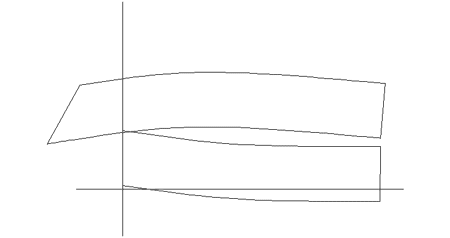Duckworks Contest #4 Entry? Not!
By Peter
H. Vanderwaart
Note:
Although the 4th annual Duckworks design contest has ended,
we have not had time to post all the entries, so we are
hoping this non-entry from Peter will tide you over. |

I had a notion for Duckworks
Contest #4. Reflecting on the Bolger Folding Schooner, I thought
perhaps a very small version could fit in a closet, as required.
At the last minute, I drew up The Folding Schoonette, and
I discovered a flaw in my theory. But since it's all drawn up,
I thought I'd let you have a peek.
I've seen a number of designs for
nesting dinghies from various designers. In the water, they do
the job, and the compactness is great aboard a cruising boat.
But the various parts don't nest very neatly in most cases, and
having to get the halves in alignment could be a problem. I thought
it might be more convenient if the two semi-boats were attached
with a pair of strong, galvanized hinges from the hardware store.
For storage, the bow could fold back over stern, as Bolger does
with his bigger schooner. I think at the time, I had some cleverer
way to fold which would keep the folded height under under 2 feet.
As shown, it's about three feet, and too fat for the contest rules.

It was fun drawing up the rig. Part
of the idea was that there would be two people to handle the sheets.
I was greatly surprised to find how hard it was to get enough
area with the schooner rig. Area is pretty much a "luff times
foot" affair, and chopping the foot into a couple pieces doesn't
change the length of luff required. The rig shown is a measly
65 sq. ft., and I don't suppose the 5 sq. ft. jib is of much value.
Even so, the mainmast is 9 feet long.

The lines are a touch unusual; let
me explain. If you try to bend most anything, you will see that
it bends mostly in the middle, and the ends are straight. This
is because you have a longer lever arm on the middle, and only
a short lever at the ends. So I drew the boat with the curves
straight both at the ends and in the middle where the two parts
join. It does look a touch unusual. Real designers like John
Welsford and Evan Gatehouse do not give in to the physics
of the material the way I have. John suggested leaving the end
of a chine, for example, long enough to lever the desired curve
into it, then cutting it to length when the epoxy set up. Evan,
for his two part dinghy, suggested building it in one piece and
then cutting it apart. It seems to me that this would put a lot
of strain on the glue and fasteners.
Enjoy! It was fun to draw, but it
will never fit in the closet. |

